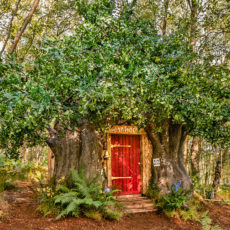
When thunderstorms hit, this bizarre electrical discharge, called a corona, forms on tree leaves. Researchers at PennState University have yet to conduct an in-depth study on this phenomenon, although they estimate that coronas generated on trees under thunderstorms could have a large impact on the surrounding air.

Why? Well, coronas product extreme amounts of the hydroxyl radical and the hydroperoxyl radical, the latter of which initiates important chemical reactions in the atmosphere that clean the air of greenhouse gases like methane while also producing ozone as well as aerosol particle pollution. Since the hydroxyl radical reacts with hydrocarbons naturally emitted by leaves to produce ozone and particulate matter, these spikes could impact air quality.
There are about two trillion trees in areas where thunderstorms are most likely to occur globally and there are 1,800 thunderstorms going on at any given time. This is definitely a process that’s going on all the time and based on the calculations we’ve been able to do so far, we think this can affect air quality in and around forests and trees,” said Jena Jenkins, a postdoctoral scholar in the Department of Meteorology and Atmospheric Science at Penn State.







